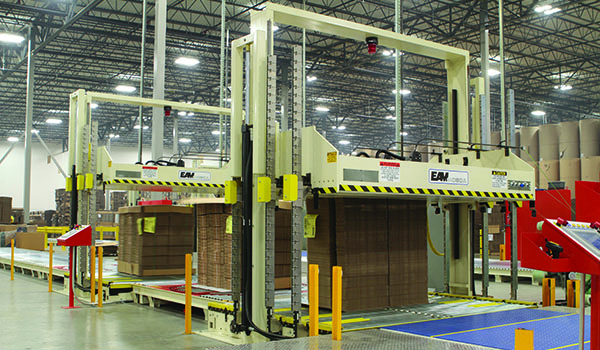Articles
Logistics I.T.

The Luxury of Logistics Excellence
To expand its footprint in the luxury accessories market, Royce Leather indulged in a solution that connects it to new customers and streamlines fulfillment. That’s how Royce rolls.
Read More
Building a Bridge to Continuous Improvement
Tired of relying on e-mail blasts to place freight, L.B. Foster ups its game with a third-party solution that has transformed the enterprise.
Read More
Filling the Manufacturing Skills Gap With Technology
Small and medium businesses (SMBs) are growing at an accelerated rate. This is all good news for manufacturers as they are seeing an increase in orders. But along with the growth, there’s the reality that manufacturers are dealing with a skills gap. Its tough to attract and retain the kind of talent they need to […]
Read More
Keeping Vendor Risk Under Control During the Holiday Season
‘Tis the season to be jolly. Yet, for logistics managers, ‘tis perhaps the most stressful time of the year. With businesses offering customers attractive deals and promises of just-in-time delivery, logistics managers are under tremendous pressure to make sure that customer orders are fulfilled in time. Nobody wants to see their name in front-page headline […]
Read More
Christopher McGovern: Watch Him Soar
Christopher McGovern is vice president, supply chain management at Aero Precision, a Greenwich AeroGroup company, headquartered in Livermore, Calif. He has held this position since 2014. Responsibilities: Inventory management, sourcing, procurement, and OEM relationships. Experience: Analyst, political/economic department, U.S. Embassy, Oslo, Norway; product researcher, OEM product research leader, program manager—U.S. government, OEM product manager—marketing, manager— […]
Read More
Trends—December 2014
10 Best Practices Of SmartWay Shippers Since 2004, the U.S. Environmental Protection Agency’s (EPA) SmartWay Transport Partnership has given organizations that ship freight a set of tools to measure their supply chain’s carbon footprint and make better decisions about how to reduce it. To mark SmartWay’s 10th anniversary, several shipper partners share their best tactics […]
Read More
Supply Chain Integration + Collaboration = Time Travel?
Debunking these five myths helps retailers and manufacturers see the real value of dedicated returns management.
Read More
The Ins and Outs of Crossdocking Solutions
Crossdocking—immediately converting inbound deliveries to outbound shipments—has become popular among shippers and third-party logistics (3PL) providers, because it reduces inventory costs and improves delivery times by eliminating intermediate warehousing activity. Effective crossdocking requires continuous real-time visibility of shipments from supplier to end customer. Unfortunately, typical enterprise resource planning (ERP) systems don’t provide granular details specific […]
Read More
Single Dashboard Streamlines Shipments
EAM-Mosca was getting buried in orders, until it strapped down a software solution to automate each step of the shipping process.
Read More
Five Key Questions to Ask a Vendor Before Buying Supply Chain Software
Cloud-based systems have changed the game for software in the supply chain, and their benefits are being applauded at every level of the spectrum. It puts software development into the hands of technology professionals and allows supply chain providers to continue focusing on their core competencies. This means that supply chain providers have access to […]
Read More
Avoiding Christmas Past: Use Technology to Ensure Timely Holiday Deliveries
The holiday season is quickly approaching, and that means it’s only a matter of time before Santa’s sleigh is filled up with presents from online orders and cross-country relatives. FedEx is anticipating an increase in holiday shipments of 8.8 percent, and UPS is anticipating an 11 percent increase over 2013. Will UPS and FedEx be […]
Read More
Three Ways a WCS Can Improve Your Operation
Just as customer expectations have become more diverse and specific over the past few years, retailers are evolving in the way they fulfill those orders. There just doesn’t seem to be a one-size-fits-all solution for distribution in the current landscape. Big retailers are automating as much of their facilities as possible and are adopting new […]
Read MoreSelecting a Yard Management System
Yard management systems (YMS) enable companies to connect to activity in the yard, on the docks, and at the gates—improving the flow of goods in and out of the facility. A YMS should be easy to use and quickly adopted by end users, recommends Nate Harris, president, Cypress Inland Corporation, a yard management software company […]
Read More
Trends—October 2014
UPS, Christmas 2014: ‘Fixed It!’ After the 2013 peak holiday season, e-commerce shoppers took to the phones and social media to tell e-tailers, and, ultimately express transportation companies, how they ruined Christmas. As it turns out, Santa actually drives a big brown truck, and he failed to get a substantial number of gifts under the […]
Read MoreLogistics Sector Leads the Internet of Things Revolution
The Internet of Things (IoT) has been hailed for years as the technology wave of the future. But while we were waiting for refrigerators that order from the store when we’re low on milk, the logistics sector has been making the first tangible forays into a real IoT environment. Using connected devices such as sensors […]
Read More
Making Hazmat Regulation Compliance Less Hazardous
Hazardous material (hazmat) transport regulations can often seem like a foreign language. An abundance of unique terms leaves many shippers perplexed. Even the phrase "hazardous materials" can be confusing because the term "dangerous goods" is standard outside the United States. And with regulations constantly shifting and changing, it gets increasingly harder for shippers to remain […]
Read More
How to Get More From Your TMS
Q: Capacity is top-of-mind today. How can supply chain partners collaborate around Transportation Management Systems (TMS) to create capacity? A: There are many ways to collaborate to generate capacity. For example, shippers are increasingly participating in general load boards, tapping into capacity that sometimes flies under the radar. To be successful, they need a TMS […]
Read More
Challenges for Today’s Global Supply Chain: Cost, Profitability and Personalization
When market research firm PWC put out its Global Supply Study in 2013, the concerns of the 500 surveyed executives were mostly what one would expect: profitability, cost management, and customer satisfaction. A fourth concern, however, indicates a shift in global supply chain realities. PWC’s study participants are worried about flexibility – and they should […]
Read More
Regulation as an Opportunity
Manufacturers are facing an increasing number of regulations in a variety of areas from increasing food safety to meeting specific ground-level ozone policies. The FDA Food Safety Modernization Act of 2010, signed into law in 2011, is just one example of recent legislation. Resulting from widespread cases of tainted eggs and peanut butter, the sweeping […]
Read More
Trends—September 2014
HCS Updates: Asked and Answered The Occupational Safety and Health Administration‘s (OSHA) 2012 Hazard Communication Standard (HCS) is sure to elicit a supply chain reaction from chemical manufacturers, distributors, and end users. The updates to HCS 1994, OSHA’s previous convention, feature some cosmetic changes—"material safety data sheets" are now referred to as "safety data sheets"— […]
Read More